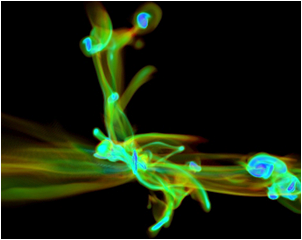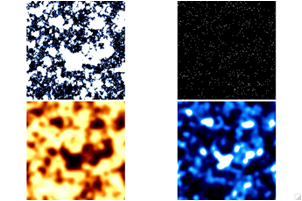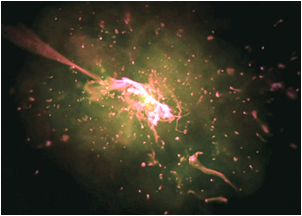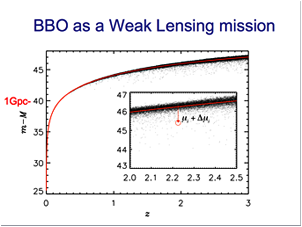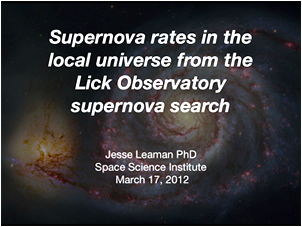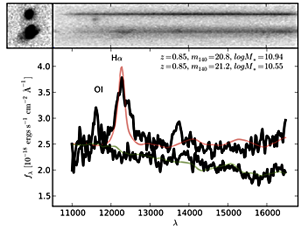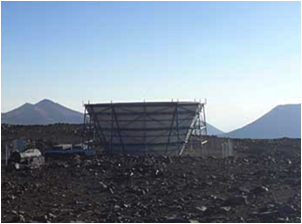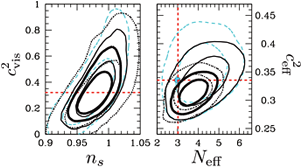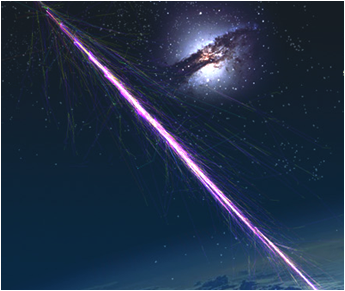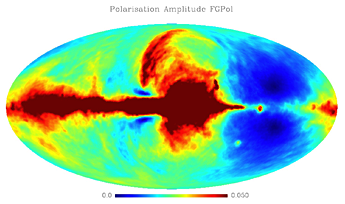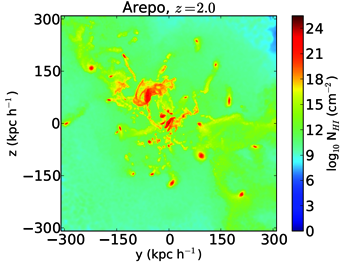 |
 |
 |
 |
 |
 |
 |
 |
 |
 |
 |
 |
|
Talks & Events
|
KICP Friday Noon Seminars: 2012 HACCing the Universe: A New Framework for Cosmological Simulations on Massively Parallel Supercomputers Cosmological simulations are crucial to maximally and robustly leverage observational information from sky surveys for cosmological inference. Ambitious surveys in the next decade will place heavy demands on our simulation capabilities. I will describe a new framework for cosmological n-body simulations called the Hardware Accelerated Cosmology Code (HACC) that we have developed in order to run efficient simulations on cutting edge and next generation High Performance Computing systems. Observing Eternal Inflation Inflation is a key component of the 'standard model' of cosmology. However, in many specific realizations of this idea, inflation is eternal and ceases only locally in 'pockets' or 'bubbles' that may become radiation- or matter-dominated. One of these could contain our observable universe. In this talk I will outline why eternal inflation is generic, how this idea can be tested through the observation of collisions between bubbles, and what it means to make predictions in an eternally inflating multiverse. Extended Lyman-alpha emission from cold accretion streams Gas accretion streams and tidal tails around redshift 3 galaxies in one of our cosmological zoom simulations. I present results from a set of cosmological simulations designed to study the observability of cold accretion streams at redshift 3 via Lyman-alpha (Lya) radiation and the feasibility of said streams as the driver of Lya blobs (or LABs). These simulations are unique because for the first time we include fully coupled radiative transfer of the UV radiation background with our newly developed RT version of the Ramses code and hence obtain a consistent model of self-shielding. This provides us with an accurate estimate of gas temperatures and neutral hydrogen fractions, which in turn allows us to accurately estimate the Lya emissivity of extended structures. I discuss the efficiency of gravitational heating in streams to power extended Lya emission and illustrate some of the complexities involved in extracting accurate observables from simulations. I show our overall resulting LAB luminosities and morphologies and compare with observations. Our main results are that the cold accretion streams in massive halos of >10^12 solar masses are capable of powering LABs and we predict that cold accretion streams should be unambiguously observable in the near future with upcoming instruments. (Based on arXiv:1112.4408v1.) Magnification and Cosmic Shear from the Sloan Digital Sky Survey Abstract: I discuss results from a cosmic shear measurement in the Sloan Digital Sky Survey. We have coadded 250 square degrees of multi-epoch SDSS imaging along the celestial equator, optimizing for weak lensing measurement. We employ standard techniques for shape measurement, shear calibration, and inference of the redshift distribution, and perform a wide array of tests that show that the systematic errors for this measurement are dominated by the statistical errors. We analyze the shear autocorrelation with and without WMAP7 priors, and produce competitive constraints on the matter density and the amplitude of the matter power spectrum. I will also discuss some new results on lensing magnification. Motivated by the need for greater signal-to-noise in weak lensing measurements, we have used tight photometric galaxy scaling relations to measure a galaxy-galaxy magnification signal with many times the signal-to-noise of earlier magnification results. I describe how minor improvements on this work may permit magnification measurements with signal comparable to shear. Weak Gravitational Lensing with the SDSS Coadd and implications for DES Reionization and CO Intensity Mapping One of the primary goals of observational cosmology at present is to detect, and elucidate the nature of, the Epoch of Reionization (EoR) when early galaxies and quasars turn on and photo-ionize 'bubbles' of neutral hydrogen gas in their surroundings. I will start by reviewing recent observational progress in understanding reionization: while these observations provide intriguing hints, they have yet to reveal a consistent story, and the detailed nature of the EoR remains mysterious. The most promising way to improve our understanding of the EoR is to detect redshifted 21 cm emission from the intergalactic medium during reionization. I will describe how measurements of large scale structure in the galaxy distribution during the EoR, while challenging, would provide an important complement to future redshifted 21 cm observations. I will discuss how it might be possible to study large scale structure during reionization using rotational emission lines from CO molecules in high redshift star-forming galaxies. Stars Formation, Black Holes, and Feedback in Galaxy Formation Many of the most fundamental unsolved questions in star and galaxy formation revolve around star formation and "feedback" from both massive stars and accretion onto super-massive black holes. The combination of models with realistic gas and feedback physics have led to huge shifts in our understanding of when and how galaxies grow, where stars form within them, and what their ultimate fate will be. I'll review the current status of our understanding of these feedback processes, and present new models which attempt to realistically model the diverse physics of the interstellar medium, star formation, and feedback from stellar radiation pressure, supernovae, and photo-ionization, and their interplay with feedback from luminous quasars. These mechanisms lead to 'self-regulated' galaxy and star formation, in which global correlations such as the Schmidt-Kennicutt law, the black hole-host galaxy correlations, and the global inefficiency of star formation emerge naturally. I'll discuss how, within galaxies, feedback regulates the structure of the interstellar medium, the collapse of dense gas into star-forming cores, and black hole accretion rates. But feedback also produces galactic super-winds that can dramatically alter the cosmological evolution of galaxies, their behavior in galaxy mergers, and structure of the inter-galactic medium. I'll highlight how a combination of improved theoretical models and observations can elucidate the physics driving these winds and their role in phenomena on an enormous range of spatial scales. Dark Matter Search with CCDs Current status of the low threshold dark matter search with CCDs in the DAMIC experiment. Cosmology with 300,000 Standard Sirens I will describe work showing that a highly sensitive deci-Hz gravitational-wave mission, like BBO or Decigo, could measure cosmological parameters, such as the Hubble constant H_0 and the dark energy parameters w_0 and w_a, more accurately than other proposed dark-energy missions, and with less problematic systematics. The basic point is that BBO's angular resolution is so good that it will provide us with hundreds of thousands of "standard sirens." These standard sirens are inspiraling neutron star and black hole binaries, with gravitationally-determined distances and optically determinable redshifts. I also explain why BBO would also be a powerful weak lensing mission, and I mention some possibilities for de-scoping the mission. Supernova rate by subclass in the local universe Expansion, acceleration and growth rate of the universe from the 6dF and WiggleZ surveys The 6dF Galaxy Survey has mapped 125,000 galaxies at a median redshift z=0.05 over the whole southern hemisphere, while the WiggleZ survey has mapped 220,000 star-forming galaxies at redshifts out to z=1 over a cubic gigaparsec. In combination, these surveys measure the evolution of the power spectrum of the galaxy distribution, including the features due to the baryon acoustic oscillations and redshift-space distortions. These measurements yield the expansion history of the universe over the last 8 billion years, and provide new and model-independent determinations of the Hubble constant at low redshift, the rate of acceleration since z=1, and the growth of large-scale structure. They also give an improved upper limit on the sum of the neutrino masses. WYSIWYG Space-Time An observationally based, non-perturbative approach to learning about the space-time geometry of our universe. On macroscopic scales new forces are determined by measuring accelerations e.g. Newton and Kepler for gravity, or balancing known with unknown forces in a static configuration. Dark energy is a putative gravitationally repulsive substance which permeates our universe, yet the evidence for it involves neither technique, but is rather a mix of observations and assumptions about the geometry of space-time and initial conditions. In fact much of cosmology is done this way. Here I examine what one can learn about space-time geometry purely by observations from a single vantage point of distant objects and their motions and, in particular, not assuming the cosmological principle. A formalism is developed whereby all of space-time geometry is expressed in terms of observables. Some new and interesting formulae are derived and a possible future path for dark energy studies is given. The rise of the red sequence: Exploring hierarchical growth with models and future prospects with the 3DHST and CANDELS surveys The massive quiescent galaxies we see at low redshifts seem to evolve slowly and passively, having formed at high redshift. The role of mergers in their formation and growth is strongly debated, as there does not seem to be much room for growth based on the observed luminosity evolution. I will describe the simple models we have used to test how hierarchical growth affects red sequence galaxies from z=1 to z=0. We find that the changes in color and luminosity for a population that builds up through mergers are very similar to those of an old, passively evolving population, but imply very different mass growth. The observed evolution can be equally well explained as the result of hierarchical growth. I will discuss how the large new surveys 3DHST and CANDELS will extend our understanding of the role of mergers and the build up of bulges to lower masses and out to higher redshifts. First results from galaxy clustering in the BOSS survey First results are presented from galaxy clustering measurements in the Baryon Oscillation Spectroscopic Survey (BOSS), which is part of SDSS-III. Data release 9, due for public release in July, contains 327,349 massive galaxies with an effective redshift z=0.57 covering 3,275 square degrees. Assuming a concordance LCDM cosmological model, this is equivalent to 0.77 h^{-3} Gpc^3, and represents the largest sample of the Universe ever surveyed at this density. I will present results including Baryon Acoustic Oscillation (BAO), Redshift-Space Distribution (RSD) measurements, and cosmological constraints from full fits to the clustering signal. In particular, including the BAO measurements alongside previous measurements, results in a BAO distance ladder, which will be compared to current supernovae measurements. New Cosmology from the South Pole Telescope I will talk about two ongoing cosmological revolutions that are fueled by high angular resolution and high sensitivity observations of the Cosmic Microwave Background: constraining the properties of the first sources of radiation in the universe via the kinetic Sunyaev-Zel'dovich effect, and constraining astroparticle and gravitational physics via lensing of the CMB. I will report on the status and prospects of these endeavors. DM-Ice: a Search for Dark Matter at the South Pole I will describe DM-Ice, a proposed dark matter experiment at the South Pole. The aim of the experiment is to test the claim for an observation of dark matter by the DAMA collaboration by carrying out an experiment with the same detector technology, but in the southern hemisphere. By going to the opposite hemisphere, many of the suspected backgrounds would produce annual modulation with the opposite phase whereas the dark matter signature should stay the same. A 17-kg detector was installed in the Antarctic ice at the South Pole in December 2010 and is currently taking data. The full-scale experiment that can test DAMA's claim is currently being designed. I will report on the status of DMIce-17 and the plans for the full-scale experiment. ACTPol: A Polarized Receiver for the Atacama Cosmology Telescope ACTPol is a ground-based experiment designed to measure the polarization of the Cosmic Microwave Background at arcminute scales. The ACTPol receiver will feature three independent arrays each with ~1000 polarization-sensitive feedhorn-coupled TES bolometers, giving a factor of ~4 improvement in sensitivity compared to the existing receiver for the 6m Atacama Cosmology Telescope (ACT). Our observation strategy will include survey regions chosen to overlap with other multi-frequency surveys. The resulting combination of sensitive maps enables a wide range of measurements and cosmological constraints including the spectrum from gravitational lensing, the sum of the neutrino masses, the number of relativistic species, the spectral shape of the primordial power spectrum, and the primordial helium abundance, along with many more. I will present an instrument overview, science goals, and the status of the first array, set to deploy this year. The Acceleration and Escape of Particles in Young Supernova Remnants The acceleration of high-energy particles to relativistic energies is a long-standing problem that has been highlighted in recent times, with the growth of various gamma-ray and cosmic ray facilities, and the Fermi space telescope. Of particular importance are the properties of the accelerator and their relation to the spectrum of accelerated particles, and the energies to which particles are accelerated. Combining numerical simulations of supernova remnant (SNR) evolution with a solution of the cosmic-ray transport equation in test-particle mode, we study the acceleration of particles at forward and reverse shocks in both Type Ia and core-collapse SNRs. We include the effect of various magnetic field profiles in the shocked interaction region. We study the temporal evolution of the non-thermal particle distribution, and synthesize surface brightness maps for various radiation mechanisms. We investigate how the spectrum of escaped particles depends on the time-dependent acceleration history in young SNRs, and calculate the time-dependent gamma-ray spectra from molecular clouds illuminated by the escaping cosmic-rays. We also study the maximum energy of the escaped particles, and its evolution with time, and provide analytic approximations for the same. Looking for cracks in the standard cosmological model: neutrinos and non-Gaussianity CANCELLED The cosmic microwave background (CMB) has provided us the laboratory in which we entered the era of 'precision cosmology'. By and large these observations have confirmed the basic, standard, cosmological model which supposes a universe seeded with Gaussian initial fluctuations and filled with non-relativistic matter, photons, and 3 neutrino species. As observations have become more accurate it has become increasingly pertinent to test some of the assumptions that have gone into building the standard cosmological model. In this talk I will present some of my recent work on testing these assumptions. First I will discuss how recent measurements of the small-scale CMB have hinted at the presence of extra relativistic energy density within the universe. Any interpretation of these results will necessitate the measurement of some of the properties of any extra relativistic energy density. Using recent small-scale measurements of the CMB, along with my colleagues, we have been able to constrain the clustering properties of the extra relativistic energy density. We show that current observations disfavor the interpretation that any extra relativistic energy consists of standard neutrinos. Second, there has been an increasing interest in testing whether the initial fluctuations follow Gaussian statistics. These tests of 'primordial non-Gaussianity' use estimators constructed from either the CMB three-point (bispectrum) or four-point (trispectrum) correlation functions. Usually an estimator constructed from data is assumed to have a Gaussian probability distribution (PDF) as a result of the central limit theorem. However, in this case the central limit theorem does not apply since the number of terms that appear in these estimators are much greater than the number of measurements. A complete knowledge of the shape of the PDF is necessary in order to properly assign confidence limits to any constraint. I will discuss how Monte Carlo simulations show that the PDF for these estimators are highly non-Gaussian themselves, necessitating more care in using these estimators, especially for future observations with the Planck satellite. I will also show how the constraining power of these estimators may be improved by using a realization-dependent normalization. Constraints on Dark Matter Parameters from Neutrino Telescope's Results CANCELLED TBA Acceleration of Galactic Cosmic Rays I will discuss the crucial role played by two phenomena that have recently been investigated in the context of cosmic ray (CR) acceleration in Galactic sources (but not only): 1) plasma instabilities induced by the streaming of accelerated particles ahead of a shock front; 2) presence of neutral atoms in the acceleration region. Both effects play a crucial role in non-linear theories of CR acceleration at shock fronts. The former is especially crucial for creating the level of magnetic turbulence required to explain both high maximum energies and the observed X-ray rims in supernova remnants. The presence of neutrals has been shown to lead to several diagnostics of the acceleration process, such as the anomalous broadening of Balmer lines from supernova shocks. Moreover, given the collisionless nature of supernova shocks (and of most astrophysical shocks) neutrals behave very differently from ions and can be shown to lead to steeper spectra of accelerated particles, as a consequence of the shock modification due to the coupling of neutrals to ions through charge exchange reactions and ionization. I will discuss these topics in direct connection with the problem of the origin of Galactic cosmic rays. Fate of cosmological solutions in massive gravity Massive gravity has self-accelerating solutions, which may account for the present day acceleration without the need for a bare cosmological constant. Generically, the value of the graviton mass is of the order of Hubble rate today. But are these solutions stable? The construction of a finite-range gravity theory has been one of the major challenges in classical field theory for the last 70 years. Recently, de Rham, Gabadadze and Tolley constructed a nonlinear theory of massive gravity, which successfully removes the unwanted extra degree that contaminated earlier constructions. The theory allows for homogeneous and isotropic solutions with self acceleration, providing an alternative to dark energy. However, the perturbation analysis shows that at linear level, these solutions contain only 2 propagating degrees of freedom, as opposed to 5 expected from a massive spin-2 particle. I will show that at nonlinear order, the additional 3 degrees acquire non-vanishing kinetic terms. For one of these degrees, the sign of the kinetic term is always negative, leading to a ghost instability in the homogeneous and isotropic background. I will conclude by presenting a new anisotropic solution which looks isotropic at the background level. For this solution, the nonlinear ghost which appears in the purely isotropic solution may be evaded. Results of dark matter searches in dwarf galaxies with Fermi I will present new results from a search for both continuum and line emission from dark matter annihilation in Milky Way dwarfs. These results are based on the joint analysis of dwarf galaxy data from the Fermi Gamma-ray Space Telescope using a statistically optimal weighting of individual photons including both spatial and spectral information. This new technique, applied to the indirect dark matter search, is strong enough to probe generic WIMP candidates that reproduce the relic abundance. I will discuss the details of the framework and how it may be applied to other situations, including making predictions for future experiments. CMB as a Probe of New Physics: The Story of Cosmic Birefringence Cosmological birefringence is a postulated rotation of the linear polarization of photons that arises due to a Chern-Simons coupling of a new scalar field to electromagnetism. In particular, it appears as a generic feature of simple quintessence models for Dark Energy, and therefore, should it be detected, could provide insight into the microphysics of cosmic acceleration. Prior work has sought this rotation, assuming the rotation angle to be uniform across the sky, by looking for the parity-violating TB and EB correlations in the CMB temperature/polarization. However, if the scalar field that gives rise to cosmological birefringence has spatial fluctuations, then the rotation angle may vary across the sky. In this talk, I will present the results of the first CMB-based search for direction-dependent cosmological birefringence, using WMAP-7 data, and report the first constraint on the rotation-angle power spectrum for multipoles up to the resolution of the instrument. I will discuss the implications for a specific (scale-invariant) model for rotation, and show forecasts for Planck and future experiments. I will then briefly comment on other parity-violating physical models, such as chiral gravity, and show how they can be distinguished from birefringent rotation. I will conclude by demonstrating how the same analysis can be used to probe inhomogeneous cosmic reionization, and discuss current constraints on a simple reionization model whose parameters can be figures of merit for future experiments. SPIDER, CMB Polarization And Modeling Polarized Microwave Foreground Emission I will give a brief update on the SPIDER experiment, a suborbital polarimeter aimed at detecting B-mode polarization of the CMB. Given that foregrounds are expected to dominate the potential B-mode signal over all targeted observing frequencies, I will move on to present templates of the dominant Galactic foreground emissions, synchrotron and thermal dust. I will describe the inputs to this model, which includes a 3D description of the Galactic magnetic field on large and small scales as well as the dust and cosmic ray density distributions and details of alignment mechanisms. These templates may prove useful for testing foreground contamination levels in patches targeted by experiments and component separation methods and in constraining parameters in Galactic magnetic field models. I will confront the model with some available data, namely the WMAP MCMC templates of foreground emission, as an indication of the reliability of the model. Galaxy evolution in groups and clusters in a hierarchical Universe Satellite galaxies in groups and clusters play a critical role in the picture of galaxy evolution. As many as a third of all galaxies are satellites, and satellite star formation quenching is the dominant process in building the red-sequence population at low mass. I will present an observational and theoretical investigation into the evolution of star formation in satellite galaxies, using the Sloan Digital Sky Survey to examine satellites across a wide range of host halo masses, from massive clusters to the lowest mass dwarf galaxy groups in the local Universe. I will place these results in a fully cosmological context using a high-resolution simulation to track satellite orbits and infall times, showing that satellite star formation histories follow a delayed-then-rapid quenching scenario. I also will examine the curious evolution of satellites that orbit beyond their host halo's virial radius. Understanding High Energy Gamma-Ray Emission from the Galactic Center Recent data taken at TeV energies (by Atmospheric Cherenkov Telescopes) and at GeV energies (by the Fermi-LAT) have opened a new window into studies of the Galactic center. The high angular resolution of these observations make them especially well-suited to understanding the many energetic processes occurring in this dense region. Interestingly, Fermi-LAT observations have uncovered an apparent excess of ~1 GeV photons peaked around the galactic center compared to the smooth power-law observed by TeV telescopes. In this talk, I will discuss several convincing models for the peculiar emission spectrum and morphology in this region, including the annihilation of particle dark matter, a yet-undiscovered population of millisecond pulsars, and hadronic emission processes from the central black hole. Additionally I will consider the extremely interesting observation by Weniger (2012) indicating the observation of a gamma-ray line by the Fermi-LAT with an energy of 130 GeV, and will briefly discuss the instrumental, dark matter, and astrophysical phenomena which may be responsible for this observation. New light on cosmic initial conditions and dark matter Deviations from adiabaticity and Gaussianity in the early universe may shed light on the physics seeding primordial fluctuations. I will discuss statistical techniques to extract local-type non-Gaussianity in the presence of the full CMB transfer function. I will discuss CMB methods to probe isocurvature fluctuations between baryons and dark matter (undetectable in linear theory), as well as a new limit to this mode. Extremely light axionic dark matter (m < 10^{-18}) is in theoretical vogue, and I will discuss ongoing work to search for such axions using large scale structure and the CMB. I will close with the results of a new telescope search for decaying relic axions. Neutral Hydrogen Absorption on a Moving Mesh I will present recent work performing cosmological simulations using the new moving mesh technique implemented in Arepo. Specifically, I have looked at the distribution of damped Lyman-alpha absorbers in Arepo, as compared to the SPH code Gadget. I have also compared the Lyman-alpha forest region between the two codes. Since both Arepo and Gadget use identical gravity solvers, but different methods for solving the Euler equations, we can use this comparison to assess how numerical effects associated with the hydro-solver impact observable results. |



